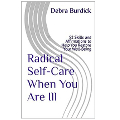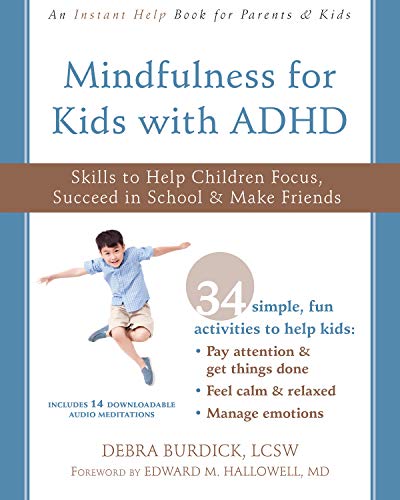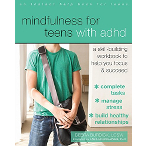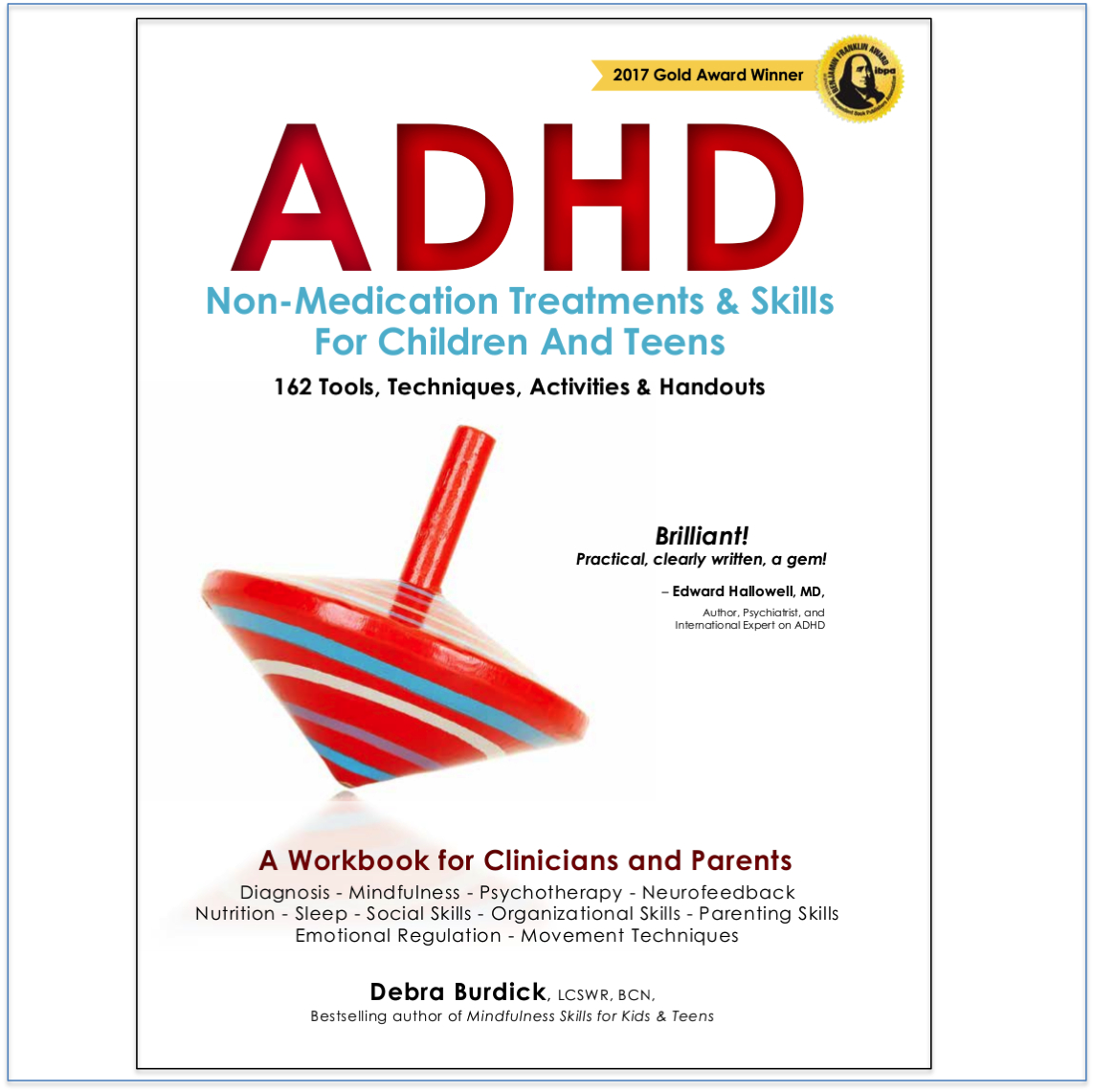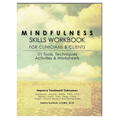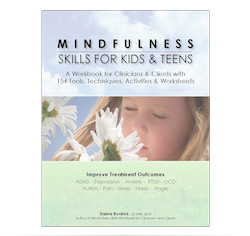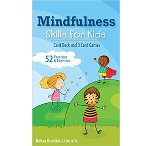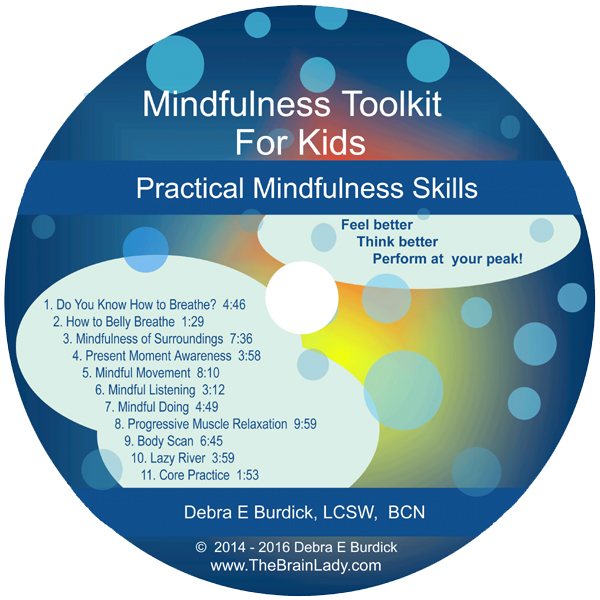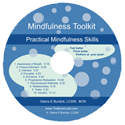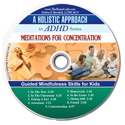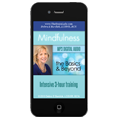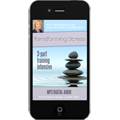Neurofeedback and Self-regulation
PLEASE NOTE: As of December 31, 2014 Deb has retired from her private practice and is no longer accepting new clients so that she can concentrate on writing and teaching. The below is for historical/informational purposes only.
Neurofeedback is a medication-free treatment for many conditions in which the brain is not working as well as it might. These include: ADHD, learning disabilities, depression, anxiety, sleep disorders, chronic pain, migraines, sleep disorders, memory, behavioral problems, addictions, traumatic brain injury, seizures, autism, anger, cooperation, trauma, and much more.
Neuroscience informs us about Neuroplasticity – the ability of the brain to change and rewire itself. Neurofeedback is an excellent example of a treatment modality that does just that. Neurofeedback is a form of biofeedback that teaches a person to change (and correct) their brain waves. It is a learning strategy that can be thought of as exercise for the brain. Information about a person’s brain wave characteristics is made available to the person via a computer. The person controls a video game without using their hands, just by learning to control their brainwaves. Pretty cool!
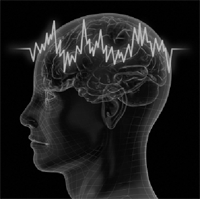 Many conditions affecting clients today can be thought of as problems in self-regulation. In other words the brain has become disregulated and stuck in patterns that don’t serve the client. This is certainly true for ADHD, depression, anxiety, brain injury, bipolar disorder, trauma, and sleep disorders. Neurofeedback teaches the brain to regular itself more effectively. It is a painless, non-invasive treatment modality that most clients find pleasant and relaxing.
Many conditions affecting clients today can be thought of as problems in self-regulation. In other words the brain has become disregulated and stuck in patterns that don’t serve the client. This is certainly true for ADHD, depression, anxiety, brain injury, bipolar disorder, trauma, and sleep disorders. Neurofeedback teaches the brain to regular itself more effectively. It is a painless, non-invasive treatment modality that most clients find pleasant and relaxing.
Neurofeeback helps regulate:
- Attention
- Behavior
- Headaches and migraines
- Depression, Anxiety, and Emotional states
- Response to stress
- Organization/Planning
- Panic Attacks
- Impulsivity
- Memory
- Obsessive/compulsive
- ANGER
- Lacking empathy
- Pain
- Sequential processing
- Sleep
Neurofeedback can treat:
- Alcoholism/Addiction
- Alzheimer’s
- Anger and Rage
- Anxiety & Panic Attacks
- ADHD
- Autistic Disorders
- Chronic Fatigue (CFS)
- Conduct Disorder
- Depression
- Eating disorders
- Epilepsy
- Learning Disabilities
- Memory
- Migraines & Tension Headaches
- PTSD
- Sleep disorders
- Stress Management
Neurofeedback is approved by the FDA for stress management.
There are a number of different types of Neurofeedback available. One, called Eeger, is a traditional type of Neurofeedback. It is based on the theory of operant conditioning where the client is rewarded with beeps, points, and game play when they are changing their brainwave patterns to healthier patterns.
Neurofeedback training is a painless, non-invasive procedure. In traditional Neurofeedback one or more sensors are placed on the scalp and one on each ear. Information about what the brain is doing is then given to the client as ‘feedback’, visually and auditorally. The brain waves are displayed on a computer in an EEG video display as well as by means of a video game. The person operates the video game with his brain. No hands! As desirable brainwave activity increases the person is rewarded by the video game moving faster, scoring points, and hearing a beep. Gradually, the brain responds to the feedback that it is given and a “learning” of new brain wave patterns takes place. The new pattern is one which is closer to what is normally observed in individuals without such conditions or disabilities.
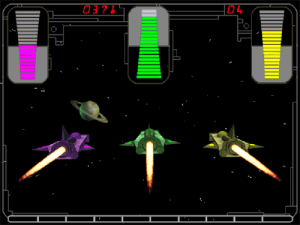
Another type of Neurofeedback, called the Low Energy Neurofeedback System (LENS), measures the brainwaves and then sends a tiny electromagnetic pulse to the brain that is offset from what the brain is doing. This gently persuades the brain to get unstuck and become more flexible. The very low power electromagnetic field is like the ones that surround digital watches and wires in the wall. Although the feedback signal is weak, it produces a measurable change in the brainwaves without conscious effort from the individual receiving the feedback.
LENS Neurofeedback uses a feedback frequency that is different from, but correlates with, the dominant brainwave frequency. When exposed to this feedback frequency, the EEG amplitude distribution changes in power. Most of the time the brain waves reduce in power; but at times they also increase in power. In either case the result is a changed brainwave state, and much greater ability for the brain to regulate itself.

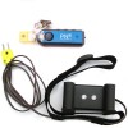 Another type of Neurofeedback, called Hemoencephalography (HEG) uses sensors on the forehead to measure and increase blood flow to the front of the brain which helps to improve many conditions.When we increase blood flow, that area of the brain is able to do its job better and more efficiently.
Another type of Neurofeedback, called Hemoencephalography (HEG) uses sensors on the forehead to measure and increase blood flow to the front of the brain which helps to improve many conditions.When we increase blood flow, that area of the brain is able to do its job better and more efficiently.
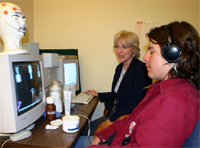 Neurofeedback is a learning strategy. The brain learns to change gradually over repeated sessions. At some point the brain has ‘got it’ and the changes stick. Some studies show that the improvements persist over time after treatment has ended as long as the treatment reinforced the changes long enough.
Neurofeedback is a learning strategy. The brain learns to change gradually over repeated sessions. At some point the brain has ‘got it’ and the changes stick. Some studies show that the improvements persist over time after treatment has ended as long as the treatment reinforced the changes long enough.
Studies show that Neurofeedback works. The American Academy of Child and Adolescent Psychiatry states that Neurofeedback meets their clinical guidelines for treatment of ADHD, learning disabilities, seizure disorders, anxiety (e.g., OCD, GAD, PTSD, phobias), depression, reading disabilities, and addictive disorders. “This finding suggests that EFB [neurofeedback] always should be considered as an intervention for these disorders by the clinician.” (Hirshberg, PhD, L, Chiu, MD, PhD, S, & Frazier, MD, J (2005). Emerging Interventions. Child and Adolescent Psychiatric Clinics of North America. 14, 1-176).
A meta-study (study of the studies) published in the May 2009 edition of Clinical EEG and Neuroscience found that “Neurofeedback treatment for ADHD can be considered ‘Efficacious and Specific (level 5)”. The Guidelines for Evaluation of Clinical Efficacy of Psychophysiological Interventions used for this study are similar to those from the American Psychological Association (APA). To meet the criteria for this highest level of efficacy, Level 5 – Efficacious and Specific, the treatment needs to be demonstrated to be statistically superior to a credible sham therapy, pill, or bona fide treatment in at least two independent studies.
(Arns, M., de Ridder, S., Strehl, U., Breteler, M. & Coenen, A. Efficacy of Neurofeedback Treatment in ADHD: The effects on Inattention, Impulsivity and Hyperactivity: a Meta-Analysis. Clinical EEG and Neuroscience; (2009), 40(3), 180-189.)
One study found that Neurofeedback works as as well as methylphenidate (Ritalin) for ADHD. Fuchs, T., Birbaumer, N., Lutzenberger, W., Gruzelier, J. H., & Kaiser, J. (2003). Neurofeedback treatment for attention deficit/hyperactivity disorder in children: A comparison with methylphenidate. Applied Psychophysiology and Biofeedback, 28, 1-12.
Here are some treatment results from some of my clients using Neurofeedback.
- The following graph shows the symptom ratings over the course of treatment for a nine year old boy, AN, who had been kicked out of regular school for violent and aggressive behavior. He was diagnosed with ADHD and oppositional defiant disorder. He was taking 3 psychotropic medications and 2 stimulants. Despite being on all this medication, he still had trouble with impulsivity, hyperactivity, concentration and cooperation. His parents had abandoned him and he lived with his grandmother. After 46 Neurofeedback sessions over the course of one year, AN was back in regular school, with good grades (A+ on his science exam), good behavior (neighbors complimenting his behavior) and a proud grandmother. And he was off all medication. He told me ‘Miss Deb, I have a new life’. In this example, symptoms were rated on a scale of 1-10 with 10 being the best.
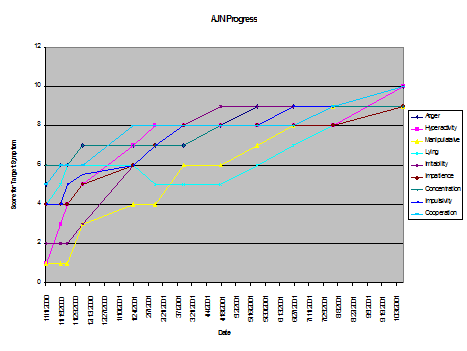
- The following is the symptom rating for a man in his late 30’s who had a lifetime of chaos and disruption from his combined symptoms of ADHD and Bipolar Disorder despite taking a combination of stimulant and mood stabilizing medications. After eight months of Neurofeedback treatment his symptoms improved as below and his medications were cut in half. By the end of treatment he had a new job in a management position and his previous cycles of rage and disruption were a thing of the past. Notice the cycles apparent in the symptom rating. In this case, zero is a perfect score.
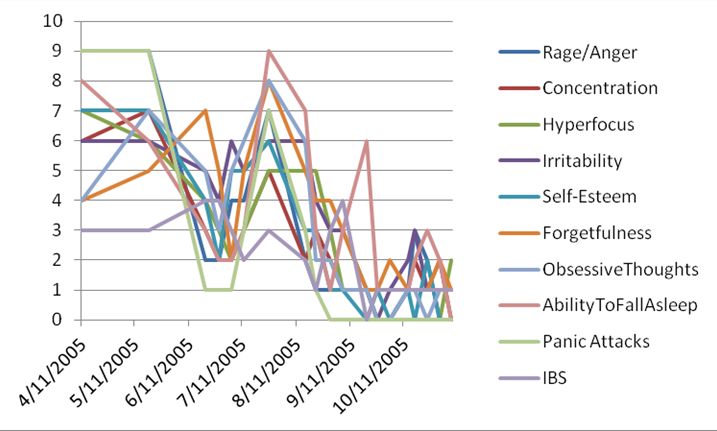
- A woman scientist came to see me because she was experiencing such severe migraine headaches that she was out of work on disability. The frequency and intensity of migraines improved dramatically over the course of Neurofeedback treatment. Below is her before and after symptom rating score chart. In this case zero is perfect/none. She was able to return to work full time and experienced improvements in many areas of her personal and work life in addition to significant reduction in migraines.
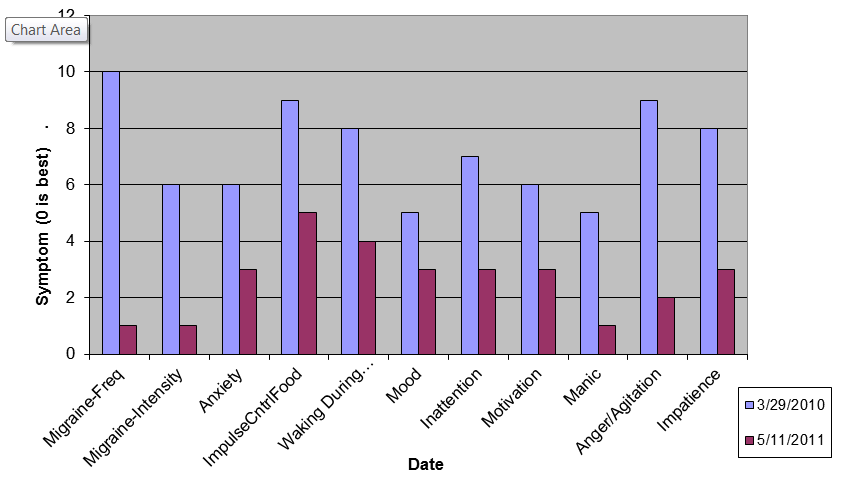
- The following video was shown on a well-known, national news show in Australia. It’s a powerful video about Neurofeedback. Even though it’s about a very difficult ADHD child, it could easily be talking about many other kinds of problems including out of control behavior, anger, and oppositional defiant disorder. This is a good example of seeing someone doing Neurofeedback and the impact on their life.
- The psychologist interviewed is a Neurofeedback colleague in Australia, Moshe Perl, Ph.D. He’s very knowledgeable, and has reported good clinical success with Neurofeedback. He’s used it with hundreds of children and adults for over 10 years. (Please note, the cost mentioned in this video is in Australian currency. Neurofeedback is an affordable, safe, and medication-free method of getting the help you or your child need.)

